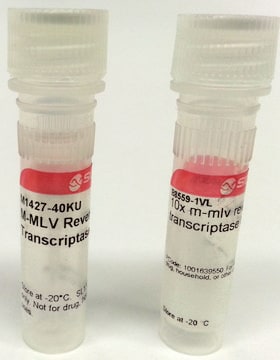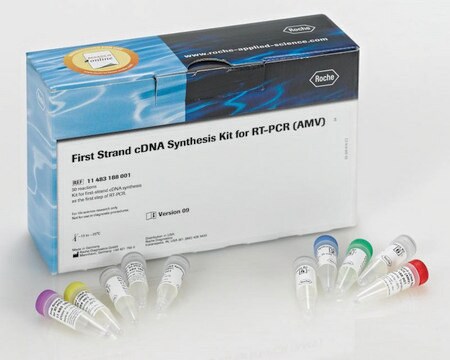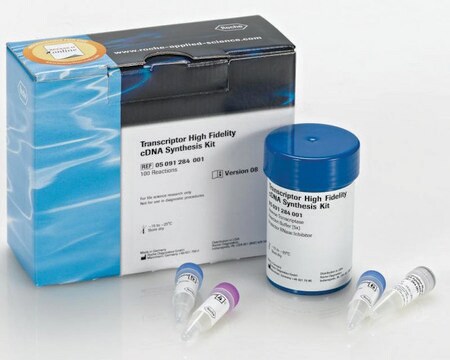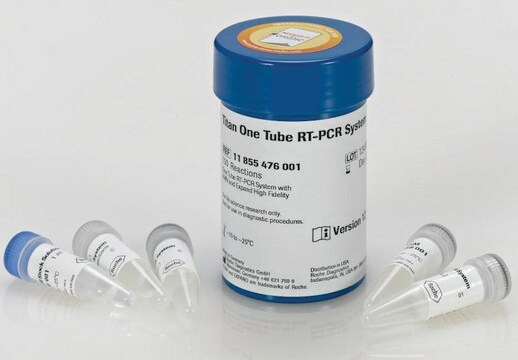Wszystkie zdjęcia(1)
Kluczowe dokumenty
10109118001
Roche
Odwrotna transkryptaza AMV
solution, >50 units/μg protein, suitable for RT-qPCR, suitable for RT-PCR
Synonim(y):
odwrotna transkryptaza amv
Zaloguj sięWyświetlanie cen organizacyjnych i kontraktowych
About This Item
Polecane produkty
Formularz
solution
Poziom jakości
aktywność właściwa
>50 units/μg protein
Właściwości
dNTPs included: no
hotstart: no
opakowanie
pkg of 1,000 U
producent / nazwa handlowa
Roche
warunki przechowywania
avoid repeated freeze/thaw cycles
Parametry
42 °C optimum reaction temp.
metody
RT-PCR: suitable
RT-qPCR: suitable
moc wejściowa
purified RNA
metoda wykrywania
probe-based
Powiązane kategorie
Opis ogólny
Reverse Transcriptase, AMV is a gene product of the RNA genome of avian myeloblastosis virus. The enzymatically active forms of the purified enzyme are α,ββ and αβ. The molecular weight of the α-subunit is 68 kDa, that of the β-subunit 92 kDa. The mature αβ form, the most active form of Reverse Transcriptase, AMV, includes a RNA-directed DNA polymerase, a DNA-dependent DNA polymerase, a RNase H, and an unwinding activity. Reverse Transcriptase, AMV is used for cDNA synthesis, for synthesis of first strand cDNA for use in subsequent amplification reactions and dideoxy DNA sequencing.
The enzyme can also be used for RNA sequencing, 3′ end labeling of DNA fragments, and the generation of ss probes for genomic footprints.
Reverse Transcriptase AMV requires a primer and Mg2+ or Mn2+ for activity.
The enzyme can also be used for RNA sequencing, 3′ end labeling of DNA fragments, and the generation of ss probes for genomic footprints.
Reverse Transcriptase AMV requires a primer and Mg2+ or Mn2+ for activity.
Specyficzność
AMV (Avian Myeloblastosis Virus) Reverse Transcriptase is an RNA-directed DNA polymerase and a DNA-dependent DNA polymerase. The AMV reverse transcriptase requires a primer and Mg2+ or Mn2+ for activity.
Heat inactivation: 5 min, 95 °C
Heat inactivation: 5 min, 95 °C
Zastosowanie
Reverse Transcriptase AMV is suitable for:
- First- and second-strand cDNA synthesis and synthesis of first strand cDNA for use in subsequent amplification reactions (RT-PCR)
- Dideoxy DNA sequencing
- Primer extension
- RNA sequencing
- 3′-end labeling of DNA fragments
- Generation of single-stranded probes for genomic footprint experiments
Cechy i korzyści
- Efficiently transcribes total RNA, mRNA, viral RNA and RNA rich in secondary structures
- Procure full length cDNA fragments up to 12 kb
- Higher thermostability (up to 60°C) and specificity than M-MuLV Reverse Transcriptase
Opakowanie
1 kit containing 2 components
Jakość
Absence of contaminants: Tested for the absence of detectable nonspecific RNases and nonspecific DNases in incubations with various nucleic acids (analyzed by gel electrophoresis) according to the current Quality Control procedures.
Function test: Reverse Transcriptase AMV is function tested in the cDNA Synthesis Kit and RT-PCR.
Function test: Reverse Transcriptase AMV is function tested in the cDNA Synthesis Kit and RT-PCR.
Definicja jednostki
1 unit is the enzyme activity that incorporates 1 nmol of [3H]-dTMP into acid-precipitable products in 10 minutes at +37 °C with poly(A)+ · d(pT)15 as template primer.
Volume Activity: 20-25 U/μl. Please refer to the Certificate of Analysis for more information.
Volume Activity: 20-25 U/μl. Please refer to the Certificate of Analysis for more information.
Uwaga dotycząca przygotowania
Storage buffer: 200 mM potassium phosphate, 2 mM dithiothreitol, 0.2% Triton X-100 (v/v), 50% glycerol (v/v), pH 7.2.
Przechowywanie i stabilność
Store at -15–-25 °C. (Storage at -70 °C is more likely to deteriorate the enzyme via repeated freezing and thawing.)
Inne uwagi
For life science research only. Not for use in diagnostic procedures.
Ta strona może zawierać tekst przetłumaczony maszynowo.
Tylko elementy zestawu
Numer produktu
Opis
- Reverse Transcriptase AMV 20-25 U/μl
- First-strand cDNA Synthesis Buffer 5x concentrated
Kod klasy składowania
12 - Non Combustible Liquids
Klasa zagrożenia wodnego (WGK)
WGK 1
Temperatura zapłonu (°F)
does not flash
Temperatura zapłonu (°C)
does not flash
Wybierz jedną z najnowszych wersji:
Masz już ten produkt?
Dokumenty związane z niedawno zakupionymi produktami zostały zamieszczone w Bibliotece dokumentów.
Klienci oglądali również te produkty
Maternal licking regulates hippocampal glucocorticoid receptor transcription through a thyroid hormone-serotonin-NGFI-A signalling cascade.
Hellstrom I C, et al.
Philosophical transactions of the Royal Society of London. Series B, Biological sciences, 367(1601), 2495-2510 (2012)
Lucile Pantel et al.
Molecular cell, 70(1), 83-94 (2018-04-07)
Growing resistance of pathogenic bacteria and shortage of antibiotic discovery platforms challenge the use of antibiotics in the clinic. This threat calls for exploration of unconventional sources of antibiotics and identification of inhibitors able to eradicate resistant bacteria. Here we
Tie-Yuan Zhang et al.
The Journal of neuroscience : the official journal of the Society for Neuroscience, 30(39), 13130-13137 (2010-10-01)
Parenting and the early environment influence the risk for various psychopathologies. Studies in the rat suggest that variations in maternal care stably influence DNA methylation, gene expression, and neural function in the offspring. Maternal care affects neural development, including the
Jessica N Saykally et al.
PloS one, 4(12), e8460-e8460 (2009-12-31)
Four genome-wide association studies mapped an "obesity" gene to human chromosome 10p11-12. As the zinc finger E-box binding homeobox 1 (ZEB1) transcription factor is encoded by the TCF8 gene located in that region, and as it influences the differentiation of
Anirudh Chakravarthy et al.
Life science alliance, 4(12) (2021-10-02)
The continued resurgence of the COVID-19 pandemic with multiple variants underlines the need for diagnostics that are adaptable to the virus. We have developed toehold RNA-based sensors across the SARS-CoV-2 genome for direct and ultrasensitive detection of the virus and
Powiązane treści
RT-qPCR wykrywa określone cele z zastosowaniami w ekspresji genów i wykrywaniu patogenów.
Nasz zespół naukowców ma doświadczenie we wszystkich obszarach badań, w tym w naukach przyrodniczych, materiałoznawstwie, syntezie chemicznej, chromatografii, analityce i wielu innych dziedzinach.
Skontaktuj się z zespołem ds. pomocy technicznej





![Enhanced Avian Reverse Transcriptase [eAMV™ RT] For reverse transcription at higher temperatures & rare mRNAs](/deepweb/assets/sigmaaldrich/product/images/496/245/af9bcef6-1474-494b-8fba-32ca0fd56c42/640/af9bcef6-1474-494b-8fba-32ca0fd56c42.jpg)



